The only nature and structure of suture are not sufficient to explain their actions or their results, so we must also talk about their different modes of installation, after the conditions for their implementation under the skin.
-
Insertion of suture in the skin :
Sutures are introduced into the superficial subcutaneous tissue (fatty tissue just under the skin), under local anaesthesia, with quite long needle but not sharp (called foam tip) in order that they do not hurt fragile elements they could cross (superficial vessels and nerves).

Depending on the type of thread, there are two insertion choices :
1 : With deep suture fixing
2 : Without deep suture fixing
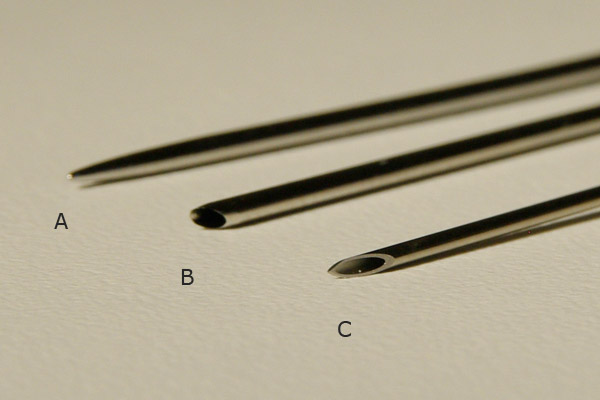
A : Atraumatic needleB : Hollow needle with smooth tip
C : Hollow needle with sharp tip
-
This implementation is actually relatively superficial, clearly differentiating from surgical actions taking place on deeper and more dangerous tissues, where there are blood vessels and large-caliber nerves whose injury can cause disasters.
In a vast majority of cases, needles pull directly threads attached thereto (setting), but the oldest sutures were introduced into hollow needles, more traumatic, that were removed after the setting up of the thread.
Once those threads are under the skin, how can you make effective sutures? It depends on the type of thread.
Some must be set deep, some do not need to. -
Implant with thread fixation by stitches :
 It is the oldest implant and concerns only loops and one-way barbed suture.
It is the oldest implant and concerns only loops and one-way barbed suture.
Without this high anchor, they could not resist the sliding of tissues that they must hold and would be taken down. It thereby blocks the thread, which already blocks tissues.
-
This setting prevents from too many variations, and occurs with one more simple stitch on a more solid surrounding tissue (fascia), sometimes reinforced by a small piece of synthetic fabric.
As we have seen previously, with loops, it is difficult to make proper adjustments of tension and symmetry before fixation. The scalp suture is often perceptible, and in order to make it more discreet, the SILHOUETTE SUTURE thread diameter was reduced to 0.2 mm.
In the case of one-way barbed suture, this fixing centralizes all suture extremities implanted, which is probably the most convenient and quickest way to operate, but it may be questionable in terms of aesthetic.
This centralized fixation point requires an opening of a few centimeters in a « safe » temporal area for the only one-way suture currently available in France, which is the SILHOUETTE SUTURE ®. Their predecessors in this type of insertion were the CONTOUR SUTURES ®, which launched barbed suture in the USA, but were abandoned for various reasons. They had very fragile notches because they were too long, and turned over with traction. Their location used a fastening that was not fully centralized, but weakly staged in 3 points.
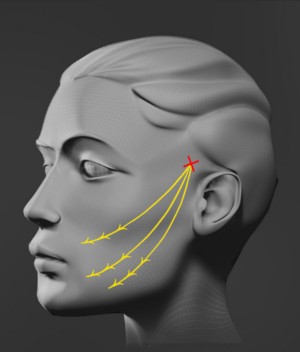
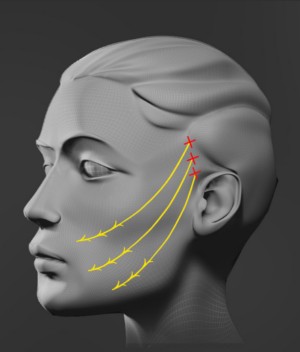
-
Implantation without fixation
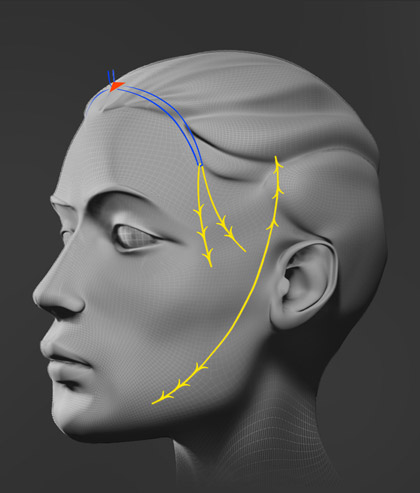 It is the rule with all two-way barbed sutures, which fixes tissues they squeeze while being fixed by them, without additional fixing point, a detail difficult to understand and that always surprises the neophyte a little.
It is the rule with all two-way barbed sutures, which fixes tissues they squeeze while being fixed by them, without additional fixing point, a detail difficult to understand and that always surprises the neophyte a little.
But this type of suture produce very different results depending on their length and number, and we should focus on this first parameter to observe how its change will improve results.
-
 A preliminary explanation is needed.
A preliminary explanation is needed.
The head can be divided into two zones, separated by a line of least resistance.
- The scalp area is solid, does not sag, and corresponds to fixed points.
- The face and neck area is weak, collapses, and corresponds to moving points.
If the length of the suture can unite those two areas and if the mechanical link thus created makes the weak zone able to support the solid zone, so we can get a good result. But if the action of the suture is confined to the weak area, you will obtain no result, and foreign body will be implanted with no benefit, which is certainly not a danger but that does not have the slightest interest.
In the light of this simple explanation, it is possible to estimate results based on the length and type of implantation for bidirectional suture.
Perhaps the reader will recognize the treatment he received. He therefore will be able to get an idea of the actual result that can be expected.
These evolutions, which are classified as simple or complex implementations, are presented in their chronological appearance, and have no other purpose than improving performance, aesthetic efficiency and durability, along with improving innocuousness.
-
Simple implantation: Short suture
 They are the first to be implanted, although not giving virtually any results. They are prone to migration and extrusions that are considerably harmful to the image of the suture.
They are the first to be implanted, although not giving virtually any results. They are prone to migration and extrusions that are considerably harmful to the image of the suture.
They shouldn’t be implanted any more.
-
5 to 12 cm long, they were first to be implanted, especially according to Sulamanidze’s protocol using APTOS suture which he invented. They are only in the weak zone (sagged skin of the face).
The real ease and rapidity of their implantation (lunch time face lift!) explain their massive use a few years ago, but their almost non existent aesthetic results in the very short term, just like suture of gold, has maintained the confusion and given to barbed sutures a reputation they do not deserve.
Moreover, because of frequent migration, those useless sutures are sometimes spontaneously evacuated through the skin or even through mucous membranes inside the mouth, which is obviously disturbing. But we must reassure those who recognize themselves in this situation because as amazing as it can seem, extrusion (exit) of a thread is commonplace and safe. In this case, it is better to help get it out completely since this suture must be either inside or outside, but not between!
Neither the doctor nor the patient should be seduced by such light techniques, in every way, because it is now sure that they have too little results and without being dangerous, they would be meaningless ... and always too expensive for what they can bring.

extrusion suture -
Simple implantations : The long suture
 Thanks to their length of 20-35 cm they link weak area and solid area with better results. However, they are still very uneven, depending a lot on the suture’s nature , too weak on heavy tissues and especially do not allow to forward the technique after implantation.
Thanks to their length of 20-35 cm they link weak area and solid area with better results. However, they are still very uneven, depending a lot on the suture’s nature , too weak on heavy tissues and especially do not allow to forward the technique after implantation.
However, it should be noted that their results improved with the last generation sutures, more elaborate one, which allows a better, much less aggressive grip and does not migrate.
It is necessary to implant a certain number of sutures on each area to ensure the result.
-
The junction between strong and weak zone gives the strength of their grip, but the suture keeps an independence which can be a weakness in certain circumstances.
The principle of a better action with a greater length being acquired, other solutions must be found to improve their performance and their duration.
Hence the idea of linking them in different ways to increase their hold and their grip on tissues.
This link works like a net which covers a surface and distribute better traction, as seen in complex implantation, while a single thread covers only a line of tension.
The complex implantations: X, EASYLIFT ® cheekbones hammock
They are possible only with long sutures. Longer to practice but allowing more durable results, it often matches the results of simple surgical facelifts and they are sometimes more natural and always safer.
-
The X coupled suture :

A mere detail of connection between two suture, introduced in 2004 (GUILLO), allowed progress towards sophisticated implantation, escaping thus from the simplistic view about barbed suture when small intervention gave small sufficient results.
Positioning two inverted V threads, then knotting the center for more strength, which gives to the two linked strands the appearance of a large X, has given more strength to the support system, and ultimately better results, photographically obvious.
-
At the same time, the technique being a little more complicated, ceased to be a "small business", and required a little more time and patience. This wasn’t appreciated nor accessible anymore to every practitioner.
A limitation of X-ribbed suture is due to the powerful traction they apply on the temples, which can cause pain or even inflammation of the adjacent hair bulbs to the point that you sometimes have to remove them in the of an aggressive suture.
The presence of the linking nodes could also be a particular factor of skin aggression (see complications) including thin skin (behind the ear) if the node contained notches, which has been the case only for a few months before knotting it on a smooth segment of thread, as suggested to the manufacturer. Last generations sutures do not have this problem and UPACTIV ® suture are also suggested by the COUSIN BIOTECH ® manufacturer in a « X » pre-knotted version.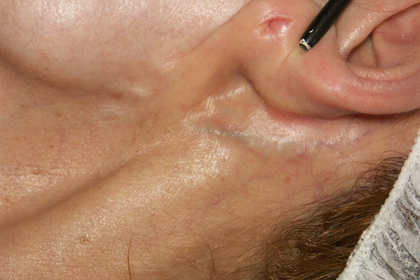

-
EASYLIFT System ® (GUILLO):
 This system located beneath the scalp and intended to support barbed suture of the face was presented in 2006.
This system located beneath the scalp and intended to support barbed suture of the face was presented in 2006.
A smooth thread replaces the barbed thread so that notches do not injure the scalp anymore.
Smooth sutures ride on the head until they reach the top of the skull and meet up, making the symmetry settings much simpler.
But one of the benefits will only be used several years later when we want to perform a new traction again on smooth threads, allowing putting the whole implanted system in tension, which remains under control. Implantation of a lens discreetly hidden in place of knots makes it simple and quick to tighten again.
Easy sketch of neck jowl cheek and temple
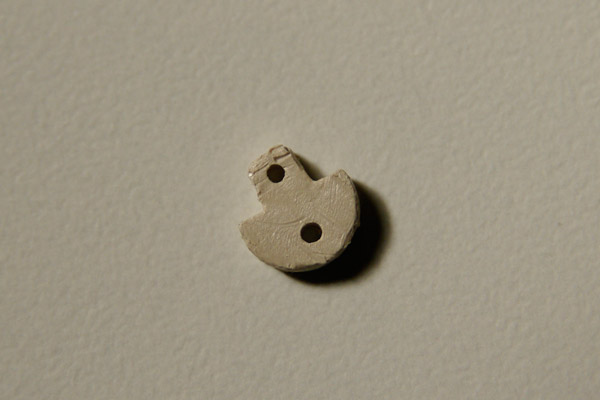
Clip
-
The aggressiveness of notches in the scalp required a solution, but the relative loss of control on implanted threads was also a former concern, older, implied by some critics.
A solution existed, which could solve both problems simultaneously;
expulsion of barbed thread in the scalp area and replacing them with smooth sutures, then, with a very simple and non-aggressive instrument, guidance of smooth threads to the top of the skull so that they intersect in one point for each level of the face, gave birth to EASYLIFT ® system.
A single junction centralizing every thread did not give a satisfactory aesthetic result, because exerted tractions just did not compensate the sagging effects. It was therefore preferable, although longer, to make a junction point per level, each of which became the very small and special place assigned to an immediate action or to a future retensioning on this single level.
We now replace knots of junctions buried under the scalp by small specific Lens-shaped clips, making identification and thread re-use easier. They are the subject of extensive researches to optimize their function.
EASYLIFT is not only a solution that replaces barbed sutures of the scalp, but also a new kind of medial fastening, non-fixed and adjustable, with lateral extensions.
This advanced system provides many benefits -strength, no thread migration, development and facilitation of setting symmetry, low aggression, potential control on thread tension- but its apparent complexity of implementation, though very limited, repels many practitioners.
However, the extension of effects over several years obtained with tension reset, highly appreciated by patients, is a benefit not to be found in any other technology, even surgery. -
Cheekbones Hammock :

The most recent refinement of implementation, presented in 2008 (GUILLO), is intended to strengthen weak or heavy cheeks. It is based on the EASYLIFT®. principle because a lateral effect is obtained
by classic lateral traction, but there is a vertical effect, with a blockade point raised with a new medial stitch exactly at the root of the nose.
This variant uses these barbed sutures as a double hammock (or straps), in order to have a combined action of down ward support and lateral traction. This arrangement, which allows a more accurate double setting, vertical and oblique, reminds us of breast support.
-
The cheekbone is a major area of the face, and its settling significantly disrupts the face. Its treatment is difficult but if it is done successfully, we obtain results with unparalleled natural look and harmony.
The sophisticated system of the cheeks hammock is done only by practitioners that have a lot of experience, not because of its dangerousness, but rather owing to the great subtlety of the tension settings of the stitch near the nose. This stitch is equivalent to high stitch of the EASYLIFT ® system, but the tension is minimal, totally different from the one applied by stitches at the top of the skull, which is pretty high.
Only last generation thread (SPRING THREADS ®) can be used in this setting, no aggressiveness of notches (APTOS ®), no fragility of thread and no lengthening after implantation (UPACTIV ®) can be tolerated in this area.
To sum up
As it can be seen, the world of suspension thread is much more complex than it seems, especially since the arrival of barbed sutures.
We can point out that they have two types of nature, permanent or absorbable, with different vocations, each with two types of structure, smooth or barbed.
Barbed suture are classified into two categories, one-way barbed sutures, already old (ALCAMO 1956), at a time when surgery was conqueror, and the latest two-way barbed sutures, (SULAMANIDZE 1997), which received many improvements in quality and in shape in recent years to become sophisticated specific implants.
Meanwhile, their implantation moved toward larger areas and treat more logically areas where settling originates (temples and cheekbones) and not only those where we can see the settling (cheeks and jowls).
Chart of the implantations, by type and length of the thread
|
| DEEP FIXATION | SIMPLE IMPLANTATION | IMPLANT. X-Y | EASYLIFT | HAMMOCK CHEEKBONE |
| BOUCLE Lisse |
|
|
|
|
|
| APTOS Bidirect. SHORT |
|
|
|
| |
| APTOS Bidirect. LONG |
|
| |||
| SILHOUETTE SUTURE Monodirect. |
|
|
|
| |
| UPACTIV Bidirect. |
|
|
| ||
| SPRING THREAD Bidirect. |
|
|
|
|
|
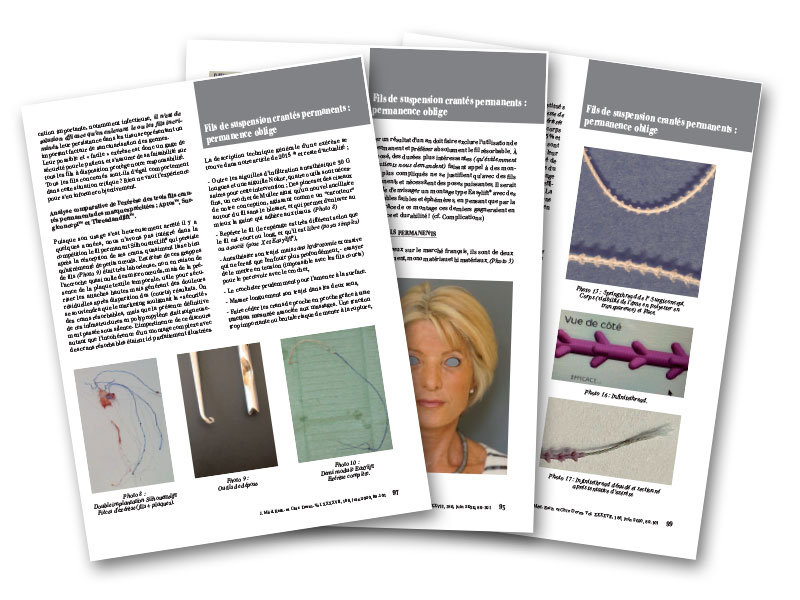 Fils de suspension crantés permanents : permanence oblige (PDF, 2020)
Fils de suspension crantés permanents : permanence oblige (PDF, 2020) 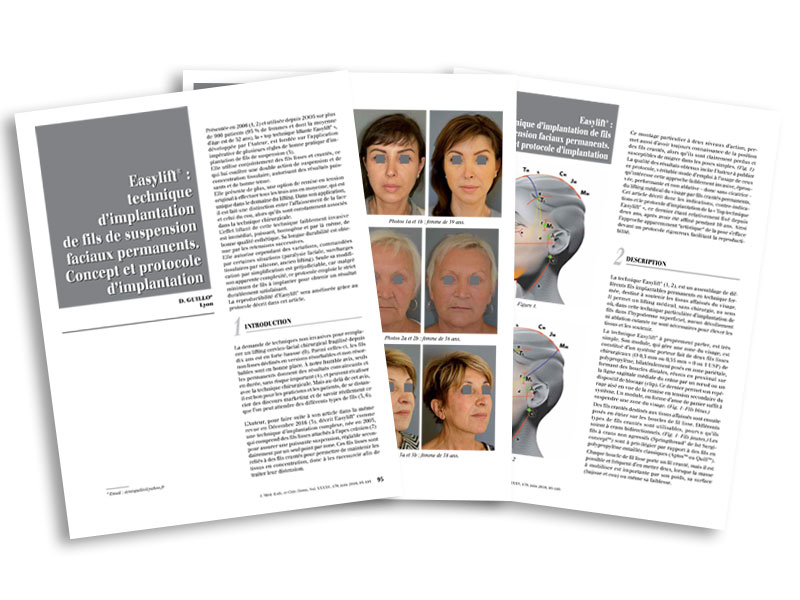 Easylift® : technique d’implantation de fils de suspension faciaux permanents.
Easylift® : technique d’implantation de fils de suspension faciaux permanents. 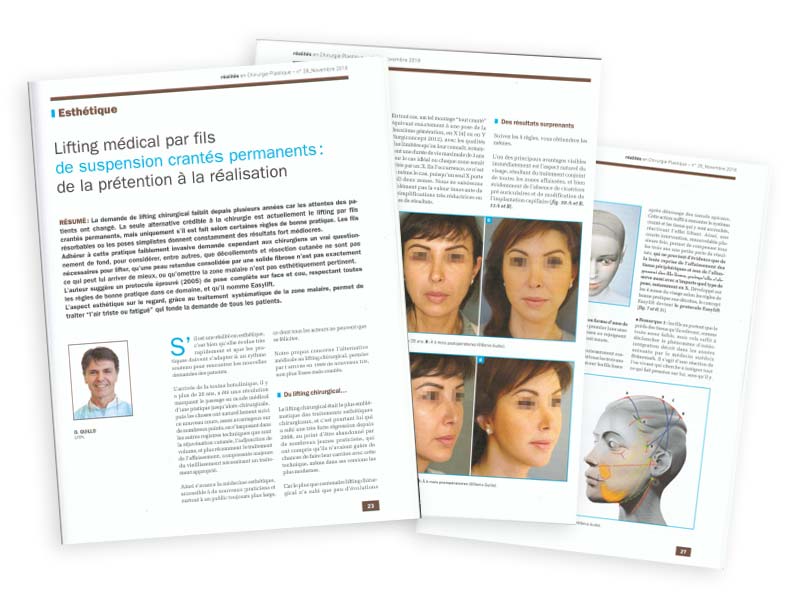 Lifting médical par fils de suspension crantés permanents
Lifting médical par fils de suspension crantés permanents 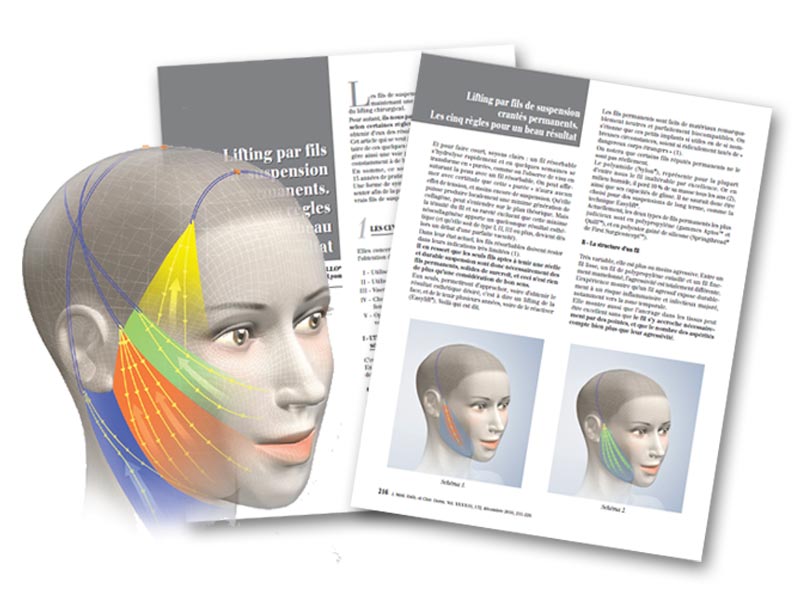 Lifting par fils de suspension crantés permanents
Lifting par fils de suspension crantés permanents 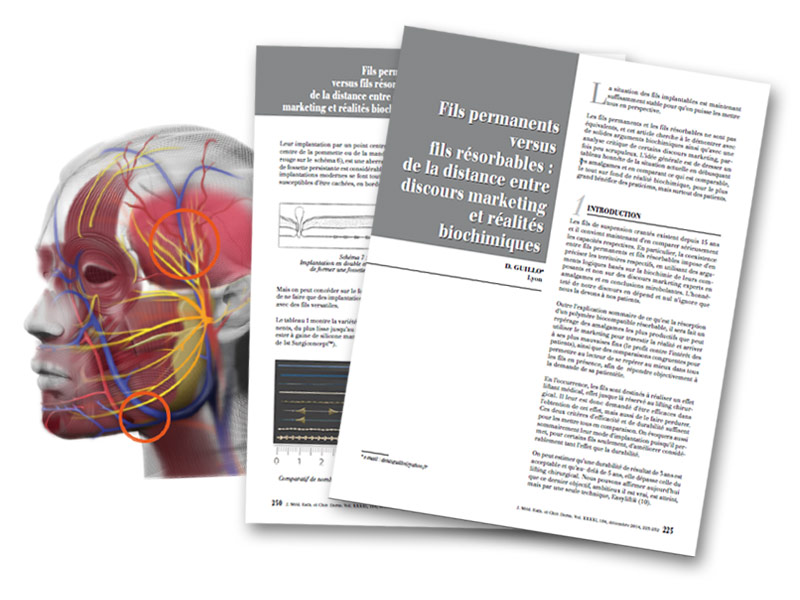 Fils permanents vs fils résorblables : de la distance entre discours marketing et réalités biochimiques
Fils permanents vs fils résorblables : de la distance entre discours marketing et réalités biochimiques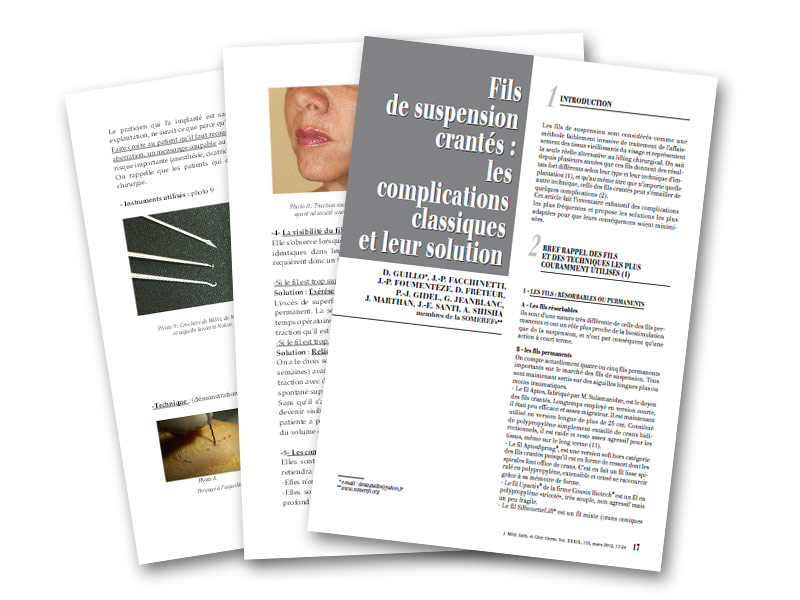 Fils de suspension crantés : Les complications classiques et leur solution.
Fils de suspension crantés : Les complications classiques et leur solution.